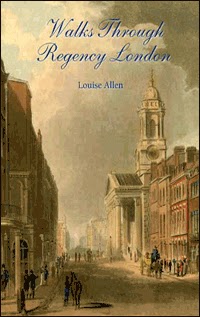According the September 2011 British Heritage magazine, the British Museum is the leader of all London attractions, with more than 5,840,000 visitors in 2010. And it is free. Yes, they ask for a contribution and special exhibitions carry an admission fee. But I suspect that many people enjoy hours and hours of browsing without paying a penny. Like most frequent London visitors, I have been many times, but I love to go back because there is always more to see. And I always leave a contribution.
On this particular visit, I was interested in seeing some of the Regency-era acquisitions on display. I have a copy of Louise Allen’s Walks Through Regency London guide book. She points out that many of treasures from the late 18th and early 19th centuries can be seen in a few rooms on the upper level. For more information on Louise, her novels and her guidebook, click here. While I had seen — many times — the most famous of the British Museum early treasures such as the Rosetta Stone and Elgin Marbles, I realized I really hadn’t spent much time looking over the less obvious items.
The display cases on the upper level were well worth close examination. Information comes from the museum’s labels. Above, four pedestals in Jasperware by Josiah Wedgwood, 1787, showing Mars, Jupiter, Cupid and Venus. Behind them, a vase with a relief of Aurora in her Chariot in Jasperware by John Turner, about 1790; Turner was the most successful of many imitators of Wedgwood’s jasperware.
Coadestone bust of John Flaxman, RA (1755-1826), English, London, late 18th century; in 1769, Eleanor Coade (1752-1821) ran a factory making a durable stoneware for outdoor use.
The Pegasus Vase, Jasperware, thrown, with applied reliefs, England, Staffordshire. Josiah Wedgwood, 1786; The main scene designed in 1778 by John Flaxman (above) is the Apotheosis of Homer, copied from a Greek vase bought by the museum in 1763 from the Hamilton Collection.
Sir William Hamilton in Jasperware with gild wood frame; England, Staffordshire, Wedgwood, 1779; Hamilton is shown in the guise of a Roman.
An aside: Sir William Hamilton (1730-1803) was a British diplomat who served as British Ambassador to the Kingdom of Naples between 1764 and 1800; he was a scientific observer of Vesuvius, and a collector of antiquities, many of which he shipped home to England and sold to the British Museum in 1772.
In 1791, at age 60, Hamilton married Emma Hart, age 26. She accompanied him back to Naples where she met and began a famous liaison with Admiral Horatio Nelson.
Copy of the Portland Vase; Jasperware, thrown, applied reliefs; England, Staffordshire, Wedgwood, c.1791; between 1786-95, Josiah Wedgwood painstakingly reproduced in black Jasperware the roman glass vase brought to England by Sir William Hamilton and lent to the potter by its owner, the Duke of Portland.
Rome 15 BC to 25 AD.
Jasperware Wine Cooler, England, Staffordshire, Etruria c. 1783, Wedgwood; applied relief designed by Lady Diana Beauclerk (1724-1808).
In a second British Museum post, we will look at a few of the recent developments in the museum itself, as well as a quick visit to the Elgin Marbles.



Did you see the Saxon horde, the recently discovered loot from a farmer's field that was unearthed by use of a metal detector?
No, I didn't go to see the Saxon materials; have to leave something for a future trip, no? I was really emphasizing, on that visit, only the things which were on view in the earliest years of the museum's existence…and there's only so much walking and standing on those stone floors!!
The British Museum was one of my favorite haunts the three years we were stationed in England. I went up to London for piano lessons and tried to arrange lessons early so I could spend some time in the museum before I had to take the train home. The Elgin Marbles and the Egyptian rooms were my favorites then.